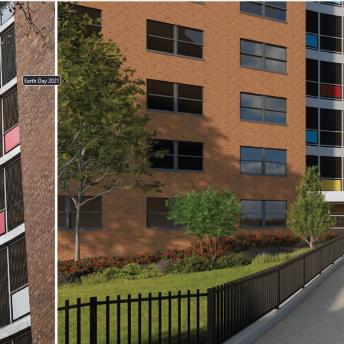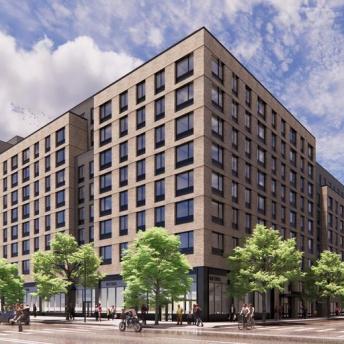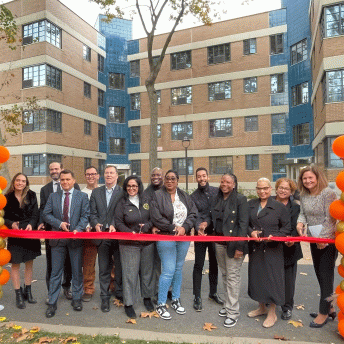Mayor Michael R. Bloomberg, Deputy Mayor for Operations Cas Holloway, Department of Housing Preservation and Development Commissioner RuthAnne Visnauskas and Mayor’s Office of Housing Recovery Operations Director Brad Gair today announced the first three properties to benefit from the NYC Build it Back multi-family building repair program. Knickerbocker Village, a State-supervised affordable housing development located on the Lower East Side in Manhattan, has received $1.46 million in relief funding to finance Phase I of repairs, and two large, multi-family properties in the Rockaways have received a combined total of $1.1 million for resiliency work. The funding provided through NYC Build it Back will help these properties – which are home to approximately 1,700 households – make much needed repairs to critical building systems and improve their resiliency in order to prevent and mitigate damage from future severe weather events. Deputy Mayor Holloway and Commissioner Visnauskas made the announcement at Knickerbocker Village, where they were joined by State Assembly Speaker Sheldon Silver, State Senator Daniel Squadron, Borough President Scott Stringer, Council Member Margaret Chin and long-time Knickerbocker Village tenant Bob Wilson.
“NYC Build it Back is an important part of our efforts help New Yorkers continue the road to recovery,” said Mayor Bloomberg. “The more than $2.5 million in assistance for these properties will help more than one thousand families get back on their feet by supporting repairs in their buildings and ensuring these locations are built resiliently to protect against future storms.”
“The assistance Build It Back is providing to Knickerbocker Village and other properties will help 1,700 families to recover from Hurricane Sandy and be better prepared for whatever climate impacts may challenge New York City in the future,” said Deputy Mayor Holloway. “Many families and businesses still need assistance and Build It Back will help thousands of families to rebuild their homes and communities better and stronger than before.”
“Today marks a new beginning for these first three multi-family buildings to receive federal recovery funding through NYC Build it Back,” said Commissioner Visnauskas. “Knickerbocker Village will use its $1.46 million to finance the first critical phase of repairs to help undo the damage caused by Hurricane Sandy. Hurricane Sandy was a turning point for how we must think about protecting our tenants and our housing stock in the face of severe weather events. It’s fitting that we memorialize this storm by moving forward and rebuilding better, smarter and stronger than before. I thank Senators Schumer and Gillibrand, Rep. Velázquez, Speaker Silver, Senator Squadron, Council Member Chin, and all of our elected officials and partners for their commitment to the recovery process.”
“The work we do on these buildings will not only benefit thousands of families, both now and in the future, but will also provide us with a model of how to make our multi-family building stock safer, stronger and more resilient to future weather events,” said Director Gair.
“On behalf of the Knickerbocker Village Tenants’ Association, I am grateful and relieved to see progress being made and promises being kept,” said Knickerbocker Village tenant Bob Wilson. “Sandy changed the way we need to look at how we maintain Knickerbocker, and keep something like this from happening again. This funding will help provide upgrades to guard the complex against disasters like Sandy, and protect our homes for the long-term. My thanks to the City for their work and partnership.”
Knickerbocker Village was constructed in 1934 and is comprised of a dozen twelve-story buildings with a total of 1,590 apartments primarily serving low-income households. The complex of buildings was heavily damaged during Hurricane Sandy. Surge waters flooded the interconnected basement level to an average depth of 70 inches, and the shared boiler room, which is located three floors below basement level, saw almost 20 feet of flooding. This flooding completely disabled the complex’s electrical and elevator systems, and caused a 20,000 gallon heating oil tank to float and rip away its piping. Nearly two weeks of pumping was required before the entire boiler room was emptied.
Temporary repairs were made by the building owners to restore heating, hot water and electricity services to residents. However, significant rehabilitation, the replacement of major building-wide systems and the installation of other resilient upgrades are critical to the long-term stability and maintenance of the property. Phase I of rehabilitation at Knickerbocker Village will use $1.46 million provided through NYC Build it Back to finance the repair of storm damage to the complex’s 12 elevator banks, which are essential to the day-to-day functioning of the buildings and safety and welfare of the tenants. The damage was extensive and repairs are needed to the governor cables, traveling cables, tensions sheaves, pit steel, basement door equipment, hall call equipment, safety switches and associated wiring, and other systems.
Engineers hired by Knickerbocker Village are working to establish a flood prevention and resiliency plan which will form the basis of Phase II of rehabilitation. Future rehabilitation will include repair and resiliency work related to the replacement of the entire electrical system and heating plant is estimated to cost more than $5 million, and NYC Build it Back will be committed to help fund the future resiliency work.
“It’s good news that these multifamily properties are using ‘Build it Back’ funds to permanently repair damage from Superstorm Sandy and prevent against future storms,” said Senator Charles Schumer. “Since the storm, money has flowed too slowly because of unnecessary red tape that needed to be cut. I am pleased that this aid is finally being distributed and utilized so that New York can be built back stronger than ever.”
“This is an important step in the recovery process for residents of Knickerbocker Village who were devastated by the unprecedented storms leveled across New York,” said Senator Kirsten Gillibrand. “This federal resource is critical for New York City families and communities hit hard by Sandy so they can continue to rebuild and get back on their feet. We will keep working together to secure every federal resource we need for a full recovery.”
“Although New York has come a long way recovering from Sandy, one year out, much work still remains,” said Congresswoman Nydia Velázquez. “This funding will help repair residences of LES working families who were affected by the storm. Going forward, we must continue to ensure there are resources at the federal, state and local levels to assist with rebuilding.”
“A year ago, the residents of Knickerbocker Village suffered terribly in the wake of Superstorm Sandy, living for weeks on end in the cold and darkness,” said Speaker Silver. “During those difficult days, I was here delivering food, water, blankets, and other essentials. I saw so many residents, many of them elderly and low-income, struggling to get by without basic services. Since then, working with the city, I have made it a top priority to ensure that Knickerbocker receives the resources it needs to repair and rebuild. I want to thank Mayor Bloomberg for his efforts in helping to make these vital repairs and for his continued support for Knickerbocker’s ongoing efforts to rebuild its infrastructure and guard against future catastrophe.”
“Knickerbocker residents dealt with the triple-whammy of Sandy: the immediate impact of Sandy as the storm surge flooded our neighborhood; weeks without heat and power; and repairs still needed a year later,” said State Senator Daniel Squadron. “These Build It Back funds will help Knickerbocker residents and others around our city continue to rebuild, and ensure that we're better prepared next time we need to be -- so that no resident has to again face those unacceptable conditions. Thank you to the City, Knickerbocker, and all of my colleagues in government who made today possible.”
“We have come very far in the year since Superstorm Sandy to increase preparedness in our homes and communities, but there is still much work to be done to ensure that we are ready for any future weather emergencies,” said Council Member Chin. “That is why the Build it Back Program is so essential – not only does it provide Knickerbocker Village the resources it needs for long-awaited building repairs, but it also allows communities to take the lessons we learned after Sandy to proactively build up resiliency. I thank the residents of Knickerbocker village for their unwavering advocacy, as well as Mayor Bloomberg, the Department of Housing Preservation and Development, and the NYC Housing Recovery Office for their commitment to a stronger and more resilient Knickerbocker Village.”
NYC Build it Back has finalized the financing $1.1 million for two properties in the Rockaways today. A 72-unit rental mixed-income rental building located at 9501 Rockaway Beach Boulevard is receiving $770,000 to make the property more resilient. The resiliency work will include the installation of a permanent emergency generator and wall-mounted boilers that will be above flood level to help ensure resistance to future flooding. Hurricane Sandy damage was repaired with insurance proceeds and existing reserves.
In addition, 334 Beach 54th Street, a 32-unit low-income rental building, is receiving $326,000 through NYC Build it Back to make the property more resilient. The resiliency work will include the installation of a permanent emergency generator on the roof. The owner took out additional market rate financing on the property to repair the damage from Hurricane Sandy that rendered six ground floor units uninhabitable. Those units should be fully repaired before the end of the calendar year.
About NYC Build it Back
The NYC Build it Back Multi-Family Program was designed to assist owners of residential properties with repairing damage from Hurricane Sandy and improving the resilience of their buildings. Rental properties, condominiums and cooperative buildings are all potentially eligible. Financial assistance is provided as a forgivable loan to cover unmet financial needs for rehabilitation of buildings that sustained serious damage. Property owners and landlords apply through the NYC Build it Back program and work with a Housing Recovery Specialist to review eligibility and options based on their specific needs. Work funded may include repairing damage to common spaces, mechanical systems, and individual apartments.
Many City, State and Federal programs and private insurance have already partially funded some of the need for landlords to undertake the rehabilitation of their properties. The City uses the Federal funding available through the NYC Build it Back program to complement and build upon these sources, such as insurance proceeds and FEMA funds. Assistance through the NYC Build it Back Multi-family repair program is prioritized to meet the needs of the city’s most vulnerable populations, including residents with low to moderate income, and properties which suffered the most severe damage.
Rehabilitating multi-family properties is one of several options offered under NYC Build it Back, which helps those affected by the storm Sandy address unmet housing recovery needs. The program can also help rebuild and repair homes damaged by Sandy, reimburse homeowners for out-of-pocket repair expenses and in some cases, acquire affected properties. For more information on NYC Build it Back, visit www.nyc.gov.
The program is overseen by Housing Recovery Office and administered by Housing Preservation and Development, along with program partners The New York City Housing Development Corporation, the Community Preservation Corporation, Local Initiatives Support Corporation, and Enterprise Community Partners.
About the Department of Housing Preservation and Development
Housing Preservation and Development is the nation’s largest municipal housing preservation and development agency. Its mission is to promote quality housing and viable neighborhoods for New Yorkers through education, outreach, loan and development programs, and enforcement of housing quality standards. It is responsible for implementing Mayor Bloomberg’s New Housing Marketplace Plan to finance the construction or preservation of 165,000 units of affordable housing by the end of fiscal year 2014. Since the plan’s inception, more than 156,397 affordable homes have been created or preserved. For more information, visit www.nyc.gov.


